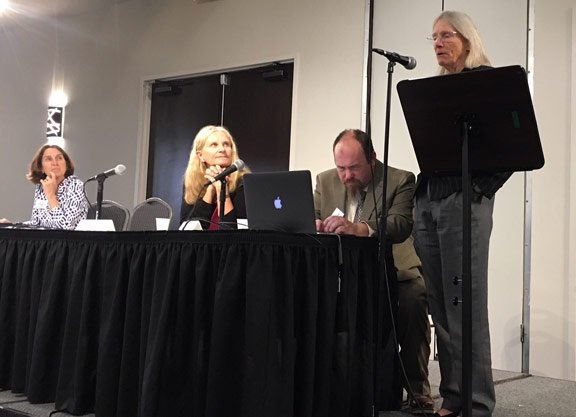Bisphosphonates–a class of drugs that prevent the bone-density loss–might have some therapeutic value for older racehorses, but speakers at the Conference on Equine Welfare and Racing Integrity warned of the potential harm caused by such treatments for young horses such yearlings and 2-year-olds.
That was among the takeaways from Wednesday's Animal Welfare Forum of the Association of Racing Commissioners International's annual conference, being held through Friday at the Hotel Hot Springs. The related discussion included how parimutuel racing's regulators might address abuse of bisphosphonates and at what stage should horses come under the jurisdiction of a racing regulatory authority.
ARCI members are the only independent entities recognized by law to license, make and enforce rules and adjudicate matters pertaining to racing.
Dr. Sue Stover, a professor at the University of California Davis School of Veterinary Medicine, said the rational for giving young horses bisphosphonates is to ward off stress fractures, joint problems and some abnormalities. “Ultimately it was just the silver bullet of preventing all these problems,” she said.
However, Stover said that bisphosphonates in young horses actually interfere with the development and growth of bone, reduce bone's ability to heal and makes bone more susceptible to cracks.
John Campbell, the legendary harness-racing driver who retired to become president and CEO of the Hambletonian Society, said the standardbred industry has had “great luck” using bisphosphonates to treat young horses with distal cannon-bone disease with “no adverse affects that I can see.”
ARCI president Ed Martin urged racing regulators to start working on a model rule as to when jurisdiction over a horse begins, which could allow them to address the concern over bisphosphonates.
“I think it would behoove all of us to work on a model regulatory policy so we have uniformity in terms of when the horse should come under the jurisdiction of the racing commission,” Martin said. “When we talk about out-of-competition testing or questioning the use of certain medications, the first thing somebody is going to say is, 'You don't have jurisdiction over this horse, and you don't regulate the practice of veterinary medicine.'”
Identifying Risk & Protective Factors in Horses
Dr. Scott Palmer, the equine medical director for the New York Gaming Association, discussed identifying risk factors in racing, including those at “boutique” meets such as Saratoga, Del Mar and Keeneland, with the inherent demands to get owners' horses to those races because of their exceptional purse money and prestige.
Palmer cited some risk factors as being on the “vets” list for an infirmity, not racing at two, trainer change, switching to a different track's surface and dropping in class. He said protective factors also must be identified.
Palmer said changes that have established themselves as diminishing risks would not all be popular and could require a change in mindset, such as writing fewer cheap claiming races, limiting the claiming purse to twice the value of the horse, consolidating race meets, biosecurity and limiting the number of stalls given the large outfits. Also mentioned: continuing education for veterinarians, trainers and assistant trainers, along with increased scrutiny of horses seeking removal from the vets list after a long layoff.
Dr. Rick Arthur advises the California Horse Racing Board on equine medication and drug testing, veterinary medicine and the health and safety of horses under CHRB's jurisdiction. After a rash of fatalities in 2016, Del Mar's actions included allowing only horses having timed workouts to be on the track for the first 10 minutes following a renovation break and giving up a week of racing to allow additional time to get the track in shape for the meet after the property was used for the San Diego County Fair
Arthur cited a study that determined horses scratched by a regulatory veterinarian did not race back for 110 days on average, while the average horse ran back in about 40 days.
“The bottom line is we're actually identifying the right horse,” he said of vet scratches. “The real issue is: are we identifying all the horses we should?”
Sports Betting: “Amazing Potential”
Horse racing, professional sports leagues and casinos are awaiting a U.S. Supreme Court decision this spring on New Jersey's challenge to the constitutionality of the Professional and Amateur Sports Protection Act (PASPA), which has made sports betting illegal except in Nevada and a few other states. The consensus of a conference panel was that sports betting could be on us extremely quickly and that racetracks and states, as well as racing regulators who in some states might oversee betting on sports, must be prepared.
Alex Waldrop, CEO of the National Thoroughbred Racing Association, said one advantage for horse racing is that the Interstate Horse Racing Act of 1978 allows bets to be made across state lines, which paved the way for simulcasting into commingled pools.
“We have some leverage,” he said. “If sports waging goes forward, you won't be able to bet across state lines” without passage of enabling federal legislation.
Not a subscriber? Click here to sign up for the daily PDF or alerts.






